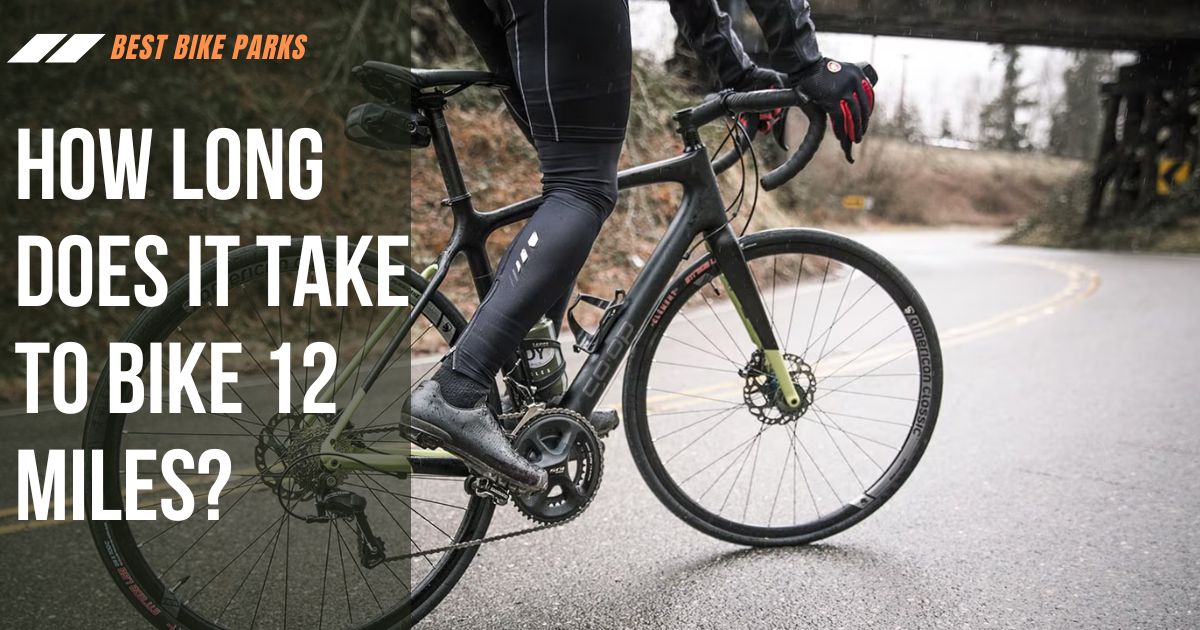Riding a bike is one of the best forms of exercise. It builds endurance, strengthens your leg muscles, and improves cardiovascular health. As a beginner, riding 12 miles may seem daunting. But with the right preparation and training, it’s an achievable goal. So how long does it take to bike 12 miles?
On average, it takes between 1 to 1.5 hours to bike 12 miles at a moderate pace on flat terrain. With consistency and targeted training, most recreational cyclists can complete a 12-mile ride in around 50 minutes. Competitive cyclists and athletes can often finish it in 40 minutes or less.
The exact duration will depend on several factors:
- Terrain
- Bike type
- Fitness level
- Weather conditions
Understanding how these factors impact your cycling time allows you to better plan rides, set real goals, and track improvements.
Factors That Determine 12 Mile Bike Ride Duration
When estimating how long it will take you to complete a 12-mile bike ride, there are four key factors that come into play: terrain, bike type, fitness level, and weather conditions. Understanding how these elements impact your ride allows you to set real goals and track your progress over time.
Terrain
The terrain you are riding on plays a significant role in your expected completion time. Riding on smooth, flat pavement with minimal stops enables the highest average speeds. Hills, uneven ground, and off-road conditions all increase the effort required by the rider and decrease overall speed.
Flat, Smooth Roads
Flat smooth roads like paved cycling paths, quiet suburban streets or open country roads provide the fastest riding surfaces. Without battling significant inclines, cyclists can easily maintain higher speeds around 15-20 mph. At this brisk pace, a 12-mile ride on flat terrain takes approximately 36-48 minutes to complete.
Hilly, Challenging Terrain
Hilly routes force riders to battle sustained climbs that sap energy and test endurance followed by skilled descents that require technical skill. The constant undulations make it harder to find an optimal rhythm and speed. Expect to work harder and ride slower managing an average speed between 10-15 mph based on hill difficulty. At these reduced paces, your 12-mile ride duration stretches to 48-72 minutes, maybe more if the inclines are especially grueling.
City Streets
Navigating busy city streets presents another terrain challenge. Frequent stops at traffic lights and signs break up momentum and make it tough to spin the pedals at top speed very long. Weaving through traffic safely also slows you down. Realistically you can expect to hold an average pace between 10-12 mph when riding 12 miles through an urban landscape. This projects out to a ride time ranging from 60-72 minutes.
Bike Type
The bike you choose also factors into your ride duration. Lightweight road bikes built purposely for speed help you ride faster with less effort. But chunky mountain bikes designed to roll over roots and rocks shine when terrain turns bumpy and steep but they sap energy on flat road stretches. Where in the middle sit hybrid bikes that balance respectable speed with a dash of durability making them more versatile across different routes.
Fitness Level
A cyclist’s physical conditioning plays a sizeable role in their ability to hold higher speeds over 12 continuous miles. Well conditioned riders with strong cardio respiratory systems possess the muscular endurance to ride at tempo for long stretches without fading. Less seasoned cyclists are more prone to fatigue forcing more recovery stops. On a flat course, fit riders should complete 12 miles comfortably between 40-60 minutes while beginners tack on an additional 20-30 minutes.
Weather Conditions
Inclement weather like strong headwinds require riders to work harder lowering sustainable speeds and increasing time to completion. Alternatively tailwinds give you a free speed boost while extreme heat and humidity sap energy and accelerate fatigue over 12 miles. Checking the forecast lets you factor conditions into your estimated ride duration.
By understanding how these four elements impact the effort and speed required over 12 miles, you can dial in more accurate ride time estimates. Tracking these variables also helps you quantify true cycling fitness gains so you can chart meaningful improvements over time through targeted training.
Tips to Improve 12 Mile Cycling Time
With dedicated training, it’s possible to significantly improve your 12-mile cycling time. Applying the following tips will build super important physiology and optimize external factors for faster ride times.
Base Building
One of the most effective ways to increase speed over 12 miles is dedicating time to gradually building your weekly mileage. Riding longer distances strengthens muscular endurance so your body grows accustomed to sustaining effort over expanding durations. Once 12 miles feels easier, you can push harder knowing your conditioning supports working at higher intensities.
Speed Training
Incorporate high intensity interval sessions into your training plan. Short bursts of maximum effort riding quickly followed by periods of easier spinning simulates the physical demands of time trialing. This overload boosts sustainable power and speed capacity.
Hill Training Seek out hilly routes or utilize incline simulation machines. Climbing builds lower body power and strength which generates more force to propel you faster on flats. Descending safely also improves bike handling skills.
Strength Training
Hitting the gym for off-bike resistance training keeps important muscle groups like your core and glutes strong for time trials. Exercises like planks, squats and lunges directly build cycling-specific muscles.
Nutrition and Hydration
Closely monitoring nutrition and hydration ensures you have enough energy and fluid for optimal performance. Complex carbs and easily digestible proteins assist recovery while electrolyte blends combat dehydration during longer rides.
Proper Rest
Getting adequate sleep and smartly scheduling training and recovery allows your body to adapt to hard efforts. Prioritize rest to enable stressed muscles actively repair and strengthen.
Bike Maintenance
Closely monitoring key components like drivetrain, tires, brakes and suspensions ensures maximum energy transfer for faster speeds. Clean drivetrains increase efficiency while grippy tires and responsive brakes enhance control.
Implementing these training fundamentals establish an athletic platform for bettering your 12-mile time trial performances. Be patient and focus on small, measurable gains that eventually accumulate into major improvements.
What Is A Good Time To Bike 12 Miles?
Determining the optimal time to tackle a 12-mile bike ride depends on your schedule, energy levels and weather preferences. While cycling can be enjoyed at any hour, targeting the early morning offers unique advantages for distance milestones versus other periods of day. Waking with enough lead time to properly prepare your mind, body and bike sets you up to maximize both performance and safety across those additional miles.
Beginning the ride early in the morning enables avoidance of peak heat and sun exposure that strains the body, saps energy and risks uncomfortable sunburn. Cooler dawn temperatures place less cardiovascular stress on systems. You efficiently self-regulate temperature in a jersey and avoid excessive fluid loss from sweating that can blunt endurance. Starting early also means biking during lighter traffic and congestion levels on roads, paths and trails. Having less vehicle presence and crowds blocking routes allows you to pedal freely without frequent stopping. This builds rhythm, momentum and speed while also enhancing safety since early morning light still illuminates you sufficiently.
Furthermore, rolling right out of bed to ride aligns with times when both mental focus and physical energy levels peak after a night’s rest. You channel that sharpness into good decision making and the natural vigor into continuous miles. As daylight hours wear on bringing stresses of work and fatigue, your performance capability dampens. Your skills and senses dull. Beginning activities fasted also triggers helpful fitness-boosting physiological adaptions. The body’s sensitivity can accelerate fitness. That does require properly hydrating and fueling light pre-ride however, hence needing lead time before hitting the road.
The key is committing training time to build necessary habit and self-discipline. But reaping the benefits of fewer distractions, cooler, less hazardous miles ultimately rewards through greater gains. You finish invigorated, accomplished and motivated to incrementally expand distances. While not always plausible for all schedules, early daylight emerges as the prime opportunity for farther cycling goals.
Determining how long it takes to bike 12 miles depends on key factors like terrain, bike type, and rider fitness. But with proper preparation, training, and riding strategy most cyclists can cover 12 miles in 1-1.5 hours on flat roads. For more tips check out the Best Bike Parks blog for their latest guidance on distance cycling, reviews, and ride suggestions to help you achieve your riding goals.









